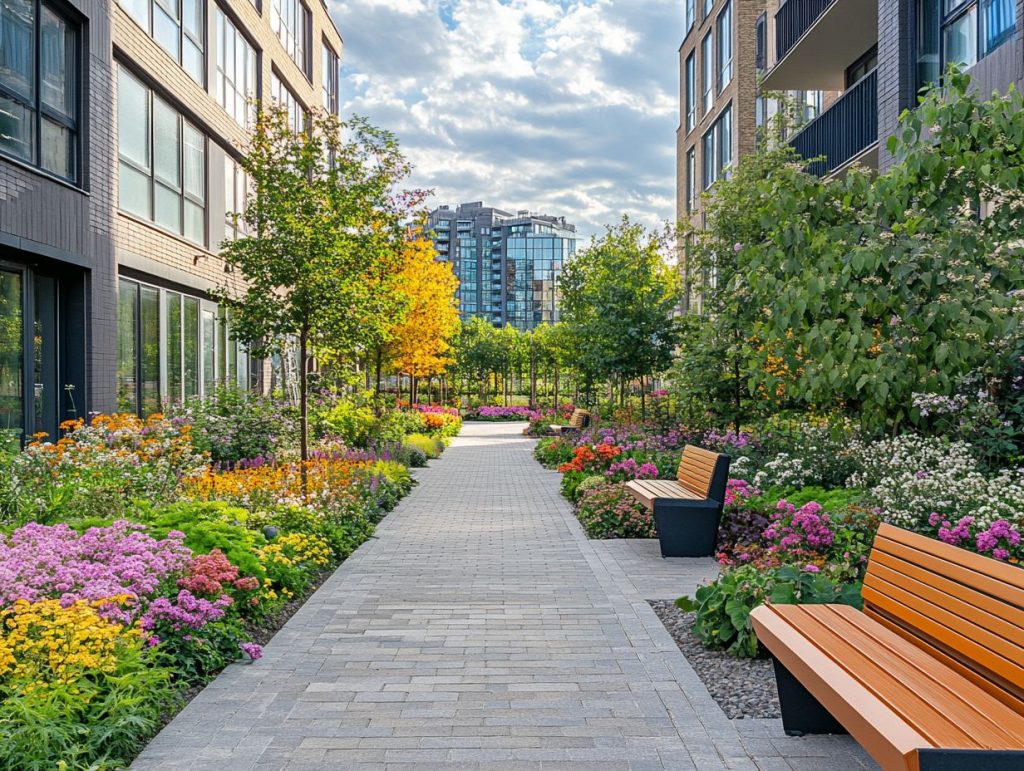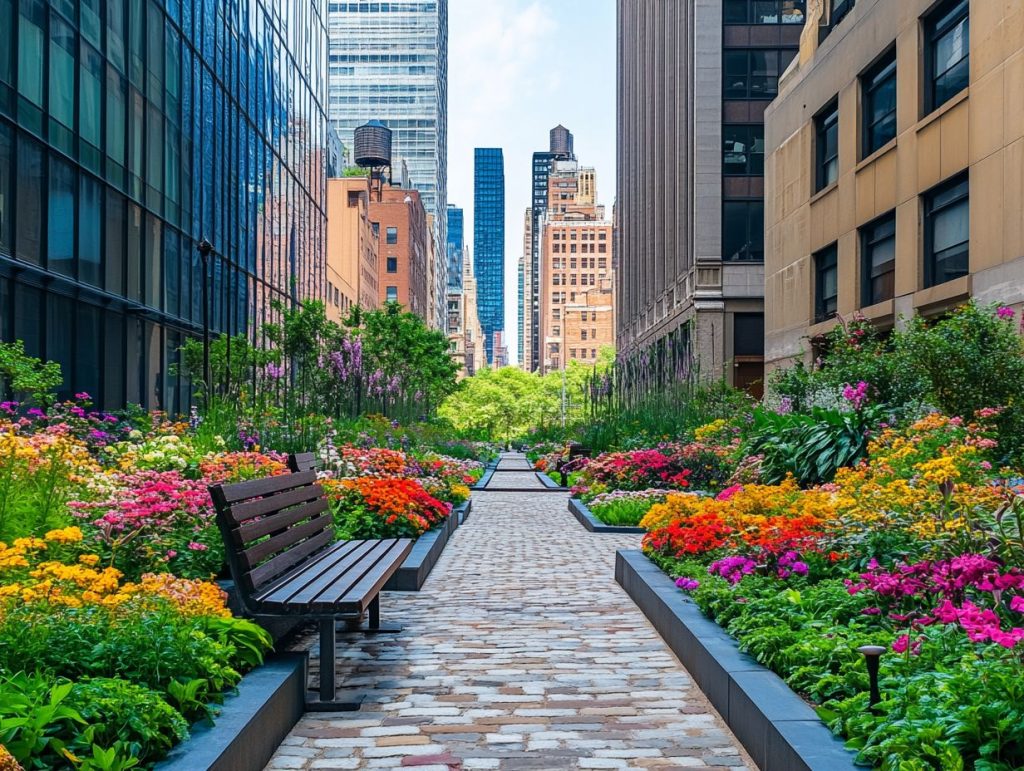Urban landscaping transforms our bustling cities into green havens, merging nature with urban life. In London, this practice enhances the city’s aesthetic appeal and offers environmental benefits, fostering biodiversity and improving air quality.
Urban landscaping presents unique challenges, such as limited space and resources. This article explores the critical elements of designing an urban landscape, selecting the right plants for London’s climate, and essential maintenance tips for long-term success.

What is Urban Landscaping?
Urban landscaping is all about designing and developing green spaces within cities—think parks, gardens, and any outdoor spots that bring a bit of nature into urban life. This approach boosts sustainability and makes city surroundings more visually appealing, providing essential ecological benefits and enjoyable places to unwind.
By adding green roofs, living walls, and community gardens, urban landscaping helps improve air quality and supports biodiversity, creating healthier and more vibrant neighbourhoods.
You cannot underestimate its importance in city planning; it shapes the physical environment and community social connections. Green infrastructure is key for managing surface water, cooling down urban heat, and providing wildlife corridors, making a city more resilient.
Getting the community involved in the landscaping process is crucial. It ensures that these spaces reflect what residents truly want and need, fostering a sense of pride and ownership.
Collaborative efforts such as community clean-up days and workshops strengthen the bond between locals and their environments, turning urban landscapes into attractive places essential to ecological and social well-being.
Benefits of Urban Landscaping
Urban landscaping offers many benefits that enhance cities’ beauty, sustainability, and livability. Integrating greenery into urban spaces improves air quality, promotes biodiversity, and creates social areas that encourage community interaction.
These advantages help cities become more resilient to climate change and enhance ecosystem services, providing you and other city residents with a greater sense of well-being and a connection to nature.
Environmental and Aesthetic Advantages
The environmental and aesthetic benefits of urban landscaping are rather impressive, aren’t they? It plays a vital role in making urban areas not just more attractive but healthier, too.
By adding features such as parks, gardens, and green belts, urban landscaping helps conserve biodiversity and create habitats for urban wildlife. These green spaces work wonders—they enhance neighbourhoods, improve air quality, and even help reduce the urban heat island effect, making cities more resilient to climate change.
Interestingly, studies show cities with plenty of green spaces, like Singapore and Vancouver, have happier residents and better mental health. For instance, research suggests that having access to parks can reduce stress levels by 30% and encourage social connections among community members.
Furthermore, these landscaped areas are biodiversity hotspots, supporting various species and boosting pollinator populations crucial for our food production.
And get this—urban greenery can lower temperatures by up to 4 degrees Celsius! That makes these green spaces essential in the fight against climate change, ultimately improving the overall quality of life for everyone in the city.

Challenges of Urban Landscaping in London
Urban landscaping in London presents many challenges, mainly because of the limited space and resources in such a densely populated city. As city planners and landscape architects work to weave more greenery into urban settings, they must tackle issues such as land scarcity, budget constraints, and the push for sustainable practices.
These hurdles call for creative landscape designs focusing on ecological health and meeting the community’s aesthetic and functional needs.
Overcoming Limited Space and Resources
Overcoming limited space and resources in urban landscaping requires innovative thinking and eco-friendly solutions. By embracing vertical gardens, green roofs, and efficient water management, you can make the most of the space available while promoting sustainability.
These strategies add some greenery, enhance the urban vibe, and improve the overall well-being of the city’s residents.
To tackle these challenges even further, consider implementing permaculture principles. Consider incorporating edible landscapes that beautify neighbourhoods and provide food resources. Community gardens are another excellent way to turn underutilised plots into vibrant hubs for residents, sparking community spirit and raising environmental awareness.
Additionally, integrating stormwater management techniques like rain gardens and bioswales can help mitigate flooding while providing a home for local wildlife. By adopting these diverse approaches, urban areas can cultivate a more resilient ecosystem, proving that nature can thrive alongside city life even in tight spaces.
Designing an Urban Landscape
Designing an urban landscape requires careful consideration of various design principles that balance aesthetics with functionality and sustainability.
To create resilient landscapes that support urban wildlife and biodiversity, you will want to incorporate native plants, boost soil health, and ensure efficient water management.
Effective landscape architecture balances the community’s needs with ecological factors, resulting in spaces that are not only beautiful but also genuinely beneficial.
Key Elements and Considerations
Some key elements make or break an urban landscape’s success and sustainability. To create inviting spaces where communities can engage and connect, consider choosing the right plants and animals, integrating green infrastructure, and considering outdoor aesthetics.
By paying attention to these aspects, you can help create vibrant environments that enhance the quality of life for everyone living in the city.
Selecting the right plants boosts visual appeal and plays a crucial role in supporting local wildlife and promoting biodiversity. Green infrastructure—such as green roofs, rain gardens, and permeable pavements—helps manage stormwater and reduce troublesome urban heat islands. These efforts can inspire residents to take pride in their surroundings and join in community activities.
By designing multifunctional spaces that cater to recreation, relaxation, and social interaction, urban landscapes become gathering spots, fostering a sense of belonging among diverse people.
Choosing Plants for Urban Landscaping
Choosing the right plants for your urban landscaping is essential for ensuring it is both sustainable and visually appealing. Native plants are an excellent choice because they thrive in local conditions, support local wildlife, and require less maintenance from you.
Furthermore, using the appropriate planting techniques can significantly enhance soil health and help your urban green spaces to be more resilient overall.
Best Species for London’s Climate
In London, selecting the best plant species for urban landscaping means getting a feel for the local climate and conditions. Some of your top choices should be resilient native species and those that thrive in urban settings, such as ornamental plants and those ideal for urban farming. These plants flourish and enhance the biodiversity and visual appeal of outdoor spaces.
Focusing on plants that can cope with the unique challenges of city life—such as pollution and compacted soil—can create vibrant green spaces that truly benefit the environment. For example, herbs like mint and rosemary offer culinary advantages while attracting pollinators, which is extremely important for urban ecology.
Shrubs such as hawthorn and ornamental grasses provide shelter for wildlife and foster a balanced ecosystem. By choosing these plants, you are supporting a larger goal of sustainability, making urban areas habitable, resilient, and ecologically rich.
Maintaining an Urban Landscape
Maintaining an urban landscape is extremely important for its long-term success and sustainability. Regular garden maintenance practices such as proper watering, pruning, and managing soil health are vital to keeping those green spaces thriving.
By adopting sustainable practices and involving the community, you can help urban landscapes flourish and provide lasting benefits for everyone in the city.
Essential Tips for Long-Term Success
For long-term urban landscaping success, you must mix best practices with community engagement. Regularly checking on the health of your plants, using sustainable methods, and getting the community involved can make a huge difference in how resilient and beautiful green spaces become. Focusing on these strategies can help urban landscapes thrive as vibrant and sustainable parts of the city.
Prioritising biodiversity by incorporating native plants is brilliant; it can boost urban ecology, attract helpful pollinators, and improve overall health. Plus, encouraging residents to join in on planting events fosters a sense of ownership and educates everyone about the environmental impacts of their choices.
Teaming with local organisations can supercharge these efforts, ensuring sustainable practices become a core part of urban development. Ultimately, building a culture of stewardship is key to bringing about lasting change, allowing cities to adapt and flourish despite the challenges of modern urbanisation.